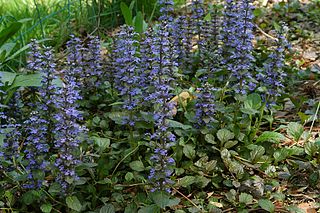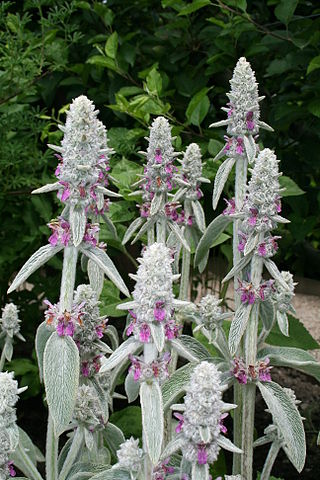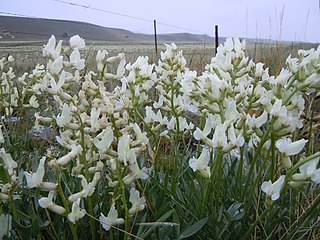
Dasiphora fruticosa is a species of hardy deciduous flowering shrub in the family Rosaceae, native to the cool temperate and subarctic regions of the northern hemisphere, often growing at high altitudes in mountains. Dasiphora fruticosa is still widely referenced in the horticultural literature under its synonym Potentilla fruticosa. Common names include shrubby cinquefoil, golden hardhack, bush cinquefoil, shrubby five-finger, widdy, kuril tea and tundra rose.

Ajuga reptans is commonly known as bugle, blue bugle, bugleherb, bugleweed, carpetweed, carpet bugleweed, and common bugle, and traditionally however less commonly as St. Lawrence plant. It is an herbaceous flowering plant in the mint family Lamiaceae, native to Europe. It is also a component of purple moor grass and rush pastures, a Biodiversity Action Plan habitat in the United Kingdom.

Pseudopanax arboreus or five finger, is a New Zealand native tree belonging to the family Araliaceae. It is one of New Zealand's more common native trees, being found widely in bush, scrub and gardens throughout both islands. The compound leaves with five to seven leaflets, hence the common name, are very characteristic of the tree and easily recognized.

Codiaeum variegatum is a species of Codiaeum, a genus of flowering plants, in the Euphorbiaceae. Initially described by Carl Linnaeus in 1753, it is native to Australasia and Oceania, from Malaysia and Indonesia in the north through northeastern Australia, as well as many Southeast Asian and South Pacific islands, growing in open forests and scrub.

Stachys byzantina, the lamb's-ear or woolly hedgenettle, is a species of flowering plant in the mint family Lamiaceae, native to Armenia, Iran, and Turkey. It is cultivated throughout much of the temperate world as an ornamental plant, and is naturalised in some locations as an escapee from gardens. Plants are very often found under the synonym Stachys lanata or Stachys olympica.

Rosa chinensis, known commonly as the China rose, Chinese rose, or Bengal rose, is a member of the genus Rosa native to Southwest China in Guizhou, Hubei, and Sichuan Provinces. The first publication of Rosa chinensis was in 1768 by Nikolaus Joseph von Jacquin in Observationum Botanicarum, 3, p. 7 & plate 55.

Oxytropis is a genus of plants in the legume family. It includes over 600 species native to subarctic to temperate regions of North America and Eurasia. It is one of three genera of plants known as locoweeds, and are notorious for being toxic to grazing animals. The other locoweed genus is the closely related Astragalus. Most oxtropis species are native to Eurasia and North America, but several species are native to the Arctic. These are hairy perennial plants which produce raceme inflorescences of pink, purple, white, or yellow flowers which are generally pea-like but have distinctive sharply beaked keels. The stems are leafless, the leaves being all basal. The plant produces legume pods containing the seeds.

Paeonia daurica is a perennial herbaceous plant belonging to the peony family. It has slender carrot-shaped roots, leaves mostly consisting of nine leaflets, with one flower per stem. The flower is subtended by none to two leafy bracts, and has two or three sepals, five to eight petals, and many stamens. The subspecies vary in the colour of the petals, the size and shape of the leaflets, and the hairiness of the leaflets and the carpels. Paeonia daurica can be found from the Balkans to Iran, and the Crimea to Lebanon, with the centre of its distribution in the Caucasus. It is also cultivated as an ornamental.

Oxytropis lambertii commonly known as purple locoweed, Colorado locoweed, Lambert's crazy weed, or Lambert’s Locoweed is a species of flowering plant in the legume family.

Clitoria fragrans is a rare species of flowering plant in the legume family known by the common name pigeon wings, or sweet-scented pigeon wings. It is endemic to Central Florida, where it was known most recently from 62 occurrences, but no current estimates of the total global population are available. The plant is a federally listed threatened species of the United States.

Oxytropis podocarpa is a species of flowering plant in the legume family known by the common names stalkpod locoweed, stalked-pod crazyweed, and Gray's point-vetch. It is native to North America, where it occurs in the northern latitudes, from Yukon and British Columbia across the low arctic to northern Quebec and Labrador. In the Rocky Mountains it occurs at the higher elevations as far south as Colorado.

Oxytropis sericea is a species of flowering plant in the legume family known by the common names white locoweed, white point-vetch, whitepoint crazyweed, and silky crazyweed. It is native to western North America from Yukon and British Columbia south through the Pacific Northwest, the Rocky Mountains, and the Great Plains.
Rubus pascuus is an uncommon North American species of brambles in the rose family. It grows only in the United States, primarily in the Ozarks of Missouri and Arkansas but with scattered populations farther east in New Jersey, Maryland, Virginia, and the Carolinas.

Oxytropis prenja G. Beck in Reichenb. & Reichenb. Fil. is a species of flowering plant in the legume family, Fabaceae.

Thaspium trifoliatum, commonly called meadow-parsnip or purple meadow-parsnip is a species of flowering plant in the carrot family (Apiaceae). It is native to eastern North America where it is found in many eastern U.S states and in Ontario, Canada. It has a broad natural habitat, which includes mesic to dry forests and woodlands, prairies, bluffs, and rock outcrops.
Zanthoxylum dissitum is a woody plant native to China. It grows in upland thickets and open forests, forests, at 300–2600 m altitude.
Zanthoxylum echinocarpum is a woody plant in the family Rutaceae and is native to South-Central and Southeast China.
Zanthoxylum laetum is a species of woody plant from the Rutaceae family.
Nephelium cuspidatum, also known as rambutan hutan in Malay and buah sibau in Iban, is a species of flowering plant, a tropical forest fruit-tree in the rambutan family, that is native to Southeast Asia.

Swainsona campestris is a species of flowering plant in the family Fabaceae and is endemic to arid areas of southern Australia. It is an erect perennial herb with imparipinnate leaves with 9 to 11 linear to narrowly lance-shaped leaflets, and racemes of pink or purple flowers in racemes of 5 to 10.
















